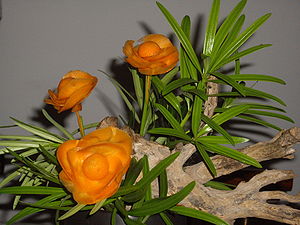
Vegetable carving
Encyclopedia

The origins of vegetable carving
The origins of vegetable carving are disputed: many people believe it to have begun in Sukothai, ThailandThailand
Thailand , officially the Kingdom of Thailand , formerly known as Siam , is a country located at the centre of the Indochina peninsula and Southeast Asia. It is bordered to the north by Burma and Laos, to the east by Laos and Cambodia, to the south by the Gulf of Thailand and Malaysia, and to the...
700 years ago, while others believe that vegetable carving originated in the time of the Tang Dynasty
Tang Dynasty
The Tang Dynasty was an imperial dynasty of China preceded by the Sui Dynasty and followed by the Five Dynasties and Ten Kingdoms Period. It was founded by the Li family, who seized power during the decline and collapse of the Sui Empire...
(AD 618-906) and the Sung Dynasty (AD 960-1279) in China.
Or perhaps Japan is the root of the art of fruit and vegetable carving, called Mukimono in Japanese. According the book "Japanese Garnishes, The Ancient Art of Mukimono", by Yukiko and Bob Haydok, Mukimono's origins began in ancient times when food was served on unglazed clay pottery. These rough platters were covered with a leaf before the food was plated. Artistic chefs realized that the cutting or folding of the leaf in different ways created a more attractive presentation. Mukimono did not become popular until the sixteenth century, the Edo period, when Mukimono gained official recognition. At this time, street artists created clever garnishes upon request. From these beginnings the art has developed into a very important part of every Japanese chef's training.
Whatever way vegetable carving originated, it is now known and practiced worldwide. Vegetable carving is flaunted in many different Asian restaurants, cruises, hotels, and other various places.
Vegetable carving initiation
The most popular theory of the history of vegetable carving is that it originates in Thailand. It started during the Loi Kratong festival in the 14th century. During Loi Kratong, rafts are individually decorated using many objects, including banana leaves and flowers.In the year 1364, one of King Phra Ruang’s servants, Nang Noppamart, had the desire to create a unique decoration for her raft. Nang carved a flower from a vegetable using a real flower as a pattern. She carved a bird as well and set it beside the flower. Using these carvings, she created a raft that stood out above the rest. King Phra Ruang was impressed by the grace and beauty of the carving and decreed that every woman should learn this new art.
As the centuries passed, enthusiasm for this art waxed and waned. In 1808, King Rama II loved vegetable carving so much so that he wrote poetry about it. However, during the 1932 revolution in Thailand, appreciation for vegetable carving died down. In order to revive interest, it is taught from the age of 11 in primary schools through secondary school in Thailand. Optional courses are also offered in universities throughout Thailand.
Vegetable carving today
In the mid 20th Century, the art of vegetable carving began to grow outside Thailand. Since then other cultures have slowly come to appreciate the beauty and culture associated with the practice. Today, one can marvel at Vegetable carving throughout the world.The products of vegetable carving are generally flowers or birds; however, the only limit is one’s imagination. The techniques of vegetable carving vary from person to person, as does the final result. Some carvings present more artistic detail, while others have simple, yet beautiful shapes. Vegetable carving is generally used as a garnish. It can also be used for flower arranging.

